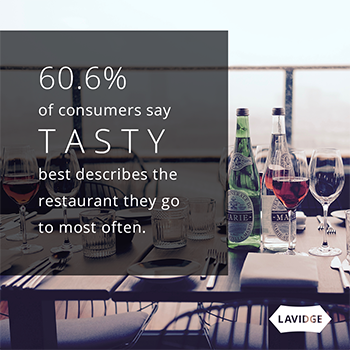Sign up for our LAVY email
and get our bi-monthly newsletter.
This article is a brief abstract of our exclusive study that takes the guesswork
out of food service advertising and marketing.
Download the complete 2017 Southwest Food Service Marketing Report
 We should have seen this coming. When asked to choose words that best described the restaurant they go to most often, 60.6% of respondents chose tasty. And at 52.4% the third most popular word was delicious. We weren’t trying to fool people; we wanted to determine how slight shades of the same word in food advertisements might resonate differently among consumers. Although they are related, tasty topped delicious by more than 8%, which is significant. The message is clear: taste must come first for marketers within the food service industry.
We should have seen this coming. When asked to choose words that best described the restaurant they go to most often, 60.6% of respondents chose tasty. And at 52.4% the third most popular word was delicious. We weren’t trying to fool people; we wanted to determine how slight shades of the same word in food advertisements might resonate differently among consumers. Although they are related, tasty topped delicious by more than 8%, which is significant. The message is clear: taste must come first for marketers within the food service industry.
Friendly was the second-most popular answer, with 54.6% of respondents preferring it well ahead of clean, value and convenience. This can be interpreted in two ways. First, it’s possible that fast-food restaurant consumers enjoy the friendly service they get from their favorite quick-service restaurants or full-service brands. Or, they might be fed up with the poor service they have experienced elsewhere.
A 2014 survey by Consumer Reports found that lack of friendliness was related to two of the top five restaurant complaints:
It might be a little sad that only 22.8% of respondents identified healthy as a word describing their most frequented restaurant. Either they are admitting to enjoying unhealthy food, or they are confused. There’s evidence it could be the latter. A 2017 survey by the International Food Information Council Foundation found that consumers are confused about what makes a food healthy. About 78% of those surveyed report finding conflicting information about what they should or shouldn’t eat. And 56% said that this made them doubt their food choices.
But it’s likely our respondents to our survey on marketing and advertising for the restaurant industry weren’t confused about what healthy means. Admitting that their favorite fast-food restaurant isn’t best described as healthy seems to be an accurate reflection of the state of American health. A 2016 poll by NPR and Truven Health Analytics found that 75% of us say we eat healthily. But there’s no compelling evidence to support that. The U.S. Centers for Disease Control and Prevention reports that more than 36% of us are obese—or about 1 in 3 adults. And 80% of us don’t eat the proper amounts of fruits and vegetables.
Survey responders said...
On Carl’s Jr.: “Their new ads are the best, just food and catchy music, no stupid beverage plug or showing college kids I can’t relate to who are laughing and eating fries. I just want to see the food and what’s in it. I don’t care how many kids are giggling hysterically over their burgers.”
On Chick-fil-A: “The ads are hilarious, but the chicken is great. I’ve never eaten anything there I didn’t like.”
Sign up for our LAVY email
and get our bi-monthly newsletter.